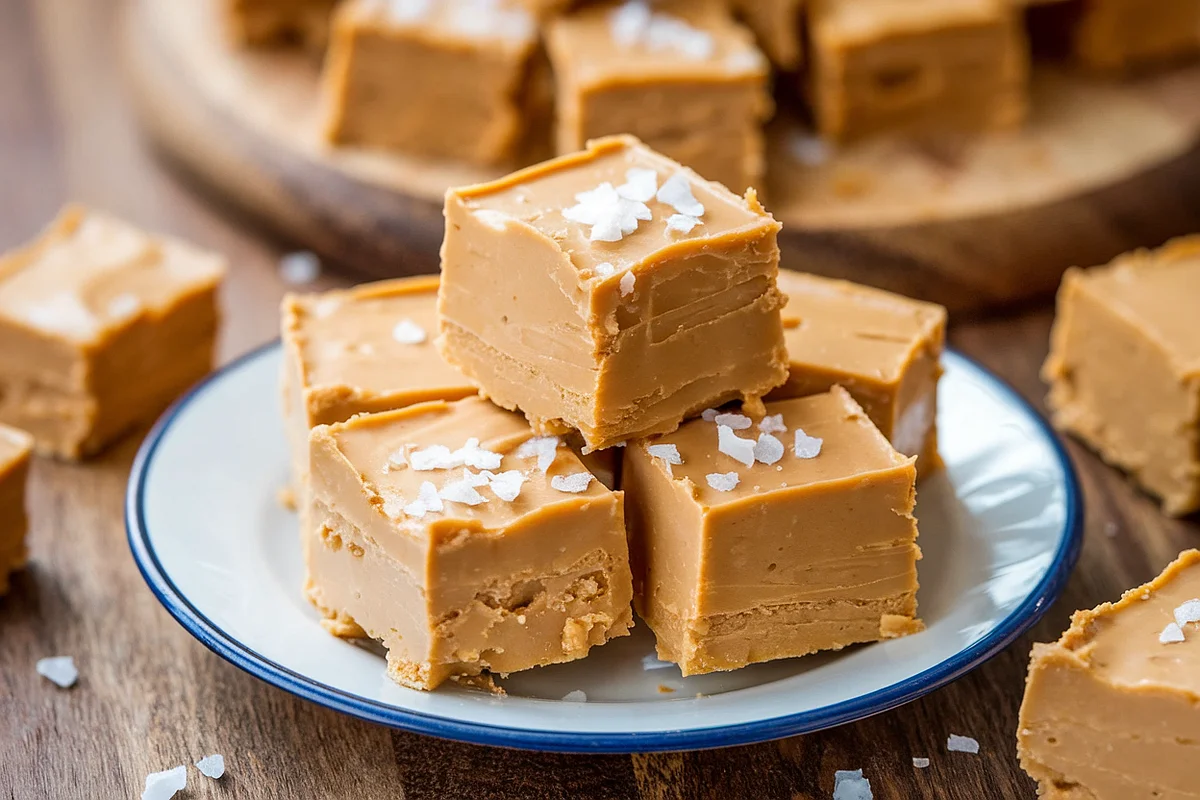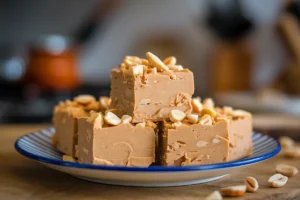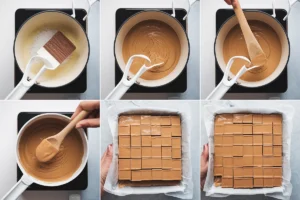When it comes to delicious, creamy, and melt-in-your-mouth treats, peanut butter fudge tops the list. This classic candy combines the rich flavor of peanut butter with the smooth, sweet consistency of fudge, creating a dessert that’s not only indulgent but also incredibly easy to make. Whether you’re a beginner or a seasoned pro in the kitchen, this guide will help you create perfect peanut butter fudge every time.
In this article, we will walk through everything you need to know about making peanut butter fudge, from understanding its basic ingredients to mastering troubleshooting tips and discovering creative serving ideas. You’ll find detailed recipes, variations, and practical advice on storage and nutritional information. Plus, we’ve included frequently asked questions to ensure your fudge-making experience is flawless.
What is Peanut Butter Fudge?
At its core, peanut butter fudge is a simple combination of a few key ingredients, including peanut butter, sugar, butter, and vanilla. What sets it apart from other types of fudge is its unique flavor profile—rich, nutty, and creamy—with a sweetness that’s perfectly balanced by the saltiness of the peanut butter. While traditional fudge can sometimes be temperamental to make, peanut butter fudge tends to be more forgiving, making it a go-to choice for novice candy-makers.
Peanut butter fudge recipes can vary widely, from stovetop versions to quick microwave options. Some recipes call for just a handful of ingredients and can be made in under 10 minutes, while others follow more traditional methods that require a bit more time and precision. Regardless of the method, the result is always delicious.
For those looking to dive deeper into candy-making, understanding the stages of sugar cooking is critical. To better grasp the process, explore candy-making tips, which can help you avoid common pitfalls when making fudge.
Key Ingredients for Peanut Butter Fudge
While the list of ingredients for peanut butter fudge is usually short, the quality and choice of these ingredients play a significant role in the final product.
- Peanut Butter: The star of the show, creamy peanut butter is the most popular choice for its smooth texture, but chunky peanut butter can be used for a bit of added crunch.
- Sugar: Most recipes call for either white granulated sugar or brown sugar, which gives the fudge a slightly deeper, caramel-like flavor.
- Butter: Adds richness and helps give the fudge its soft, melt-in-your-mouth texture.
- Vanilla Extract: A splash of vanilla enhances the overall flavor and complements the peanut butter perfectly.
Optional ingredients can include marshmallow cream, chocolate, or even nuts, depending on the variation you’re making. Using natural peanut butter is another alternative that can create a different texture and taste, but it’s essential to adjust the recipe slightly to account for the oil separation that can occur.
For those seeking healthier options, you can explore a vegan peanut butter fudge recipe, which substitutes dairy-based ingredients with plant-based alternatives.
Popular Peanut Butter Fudge Variations
One of the best things about peanut butter fudge is its versatility. Below are a few popular variations that cater to different tastes and dietary needs.
1. Old-Fashioned Peanut Butter Fudge
Old-fashioned peanut butter fudge is made using a combination of brown sugar and milk, giving it a rich, slightly caramelized flavor. This recipe usually requires the stovetop and a bit more time, but the results are worth it.
- Ingredients:
- 2 cups brown sugar
- 1 cup whole milk
- 1 ½ cups creamy peanut butter
- 1 tablespoon butter
- 1 teaspoon vanilla extract
- Instructions:
- Combine the brown sugar and milk in a saucepan over medium heat.
- Bring the mixture to a boil, stirring frequently.
- Remove from heat and stir in the peanut butter, butter, and vanilla.
- Pour into a buttered pan and allow it to cool before cutting into squares.
2. Microwave Peanut Butter Fudge
For those short on time, microwave peanut butter fudge is a quick and easy alternative that still delivers all the flavor and creaminess you expect from traditional fudge.
- Ingredients:
- 2 cups creamy peanut butter
- 1/2 cup butter
- 2 ½ cups powdered sugar
- 1 teaspoon vanilla extract
- Instructions:
- Microwave the peanut butter and butter together for 1 minute or until melted.
- Stir in the vanilla and powdered sugar until smooth.
- Press the mixture into a pan and refrigerate for 2 hours until set.
3. Chocolate Peanut Butter Fudge
For chocolate lovers, this variation combines the best of both worlds: chocolate and peanut butter. You can either swirl chocolate into the peanut butter fudge or layer the two flavors for a stunning visual effect.
4. Vegan Peanut Butter Fudge
If you’re dairy-free, you don’t have to miss out on this delightful treat. Vegan peanut butter fudge uses coconut oil in place of butter and often swaps regular sugar for coconut sugar or maple syrup.
Step-by-Step Recipe for Basic Peanut Butter Fudge
Here’s a foolproof recipe for basic peanut butter fudge that delivers rich, creamy results every time.
Ingredients:
- 2 cups creamy peanut butter
- 1/2 cup unsalted butter
- 3 cups powdered sugar
- 1 teaspoon vanilla extract
Instructions:
- Line an 8-inch square pan with parchment paper.
- In a microwave-safe bowl, combine the peanut butter and butter. Microwave on high for 1 minute or until both are melted and smooth.
- Stir in the vanilla extract and powdered sugar, mixing until fully combined and smooth.
- Pour the mixture into the prepared pan, spreading it evenly.
- Refrigerate for at least 2 hours or until firm.
- Cut into squares and enjoy!
The Role of Texture in Perfect Fudge
One of the key elements that sets great peanut butter fudge apart is its texture. Achieving the right balance between creamy and firm is crucial to delivering that melt-in-your-mouth experience. The use of ingredients like butter and sugar contributes to this, but precise timing and temperature control also play an essential role. Ensuring that the sugar reaches the soft-ball stage helps create that smooth consistency without becoming too hard or grainy. If you want to experiment with different textures, you can also try adding mix-ins like crushed nuts or marshmallows for an extra bite.
Troubleshooting Common Peanut Butter Fudge Issues
Even with a relatively simple recipe, issues can arise when making peanut butter fudge. Here are a few common problems and solutions.
1. Why Is My Fudge Not Setting?
If your fudge remains too soft or runny, it’s likely due to undercooking the sugar mixture. Ensuring the sugar mixture reaches the soft-ball stage (235°F) is crucial for stovetop versions. For microwave versions, make sure the peanut butter and butter mixture is fully combined and the powdered sugar is well-incorporated.
2. Why Is My Fudge Grainy?
Grainy fudge is usually caused by crystallized sugar. To avoid this, make sure you’re stirring the mixture thoroughly and avoiding any undissolved sugar in the recipe.
3. How to Store Fudge?
For the best results, peanut butter fudge should be stored in an airtight container at room temperature for up to a week. If you need to keep it longer, refrigerate or freeze it.
For more detailed advice, check out these tips for fudge-making, which cover the importance of temperature control.
Creative Ways to Serve Peanut Butter Fudge
Peanut butter fudge isn’t just a standalone dessert. It’s versatile and can be used in various creative ways.
- Holiday Treat: Peanut butter fudge makes a fantastic addition to holiday gift baskets or dessert platters. Wrap it in festive paper or boxes for a homemade touch.
- Dessert Topping: Cut small pieces of fudge and sprinkle them over ice cream, or use them as a topping for cupcakes or brownies.
- Fudge Sundaes: Create a decadent sundae by combining fudge pieces with vanilla ice cream and hot fudge sauce.
Seasonal Variations
Peanut butter fudge can be easily customized for different holidays. Try adding pumpkin spice for a fall-themed treat or peppermint extract during the winter holidays.
Nutritional Information for Peanut Butter Fudge
While peanut butter fudge is undoubtedly a sweet indulgence, it’s helpful to know what you’re consuming. Below is a general breakdown of the nutritional content per 1-inch square of basic peanut butter fudge.
- Calories: 90–120
- Fat: 5g–7g
- Sugar: 10g–14g
- Protein: 2g–4g
For those following specific dietary plans, there are numerous ways to adapt the recipe, such as using low-sugar or gluten-free ingredients.
Frequently Asked Questions About Peanut Butter Fudge
Here are some common questions people ask when making peanut butter fudge:
1. What is the secret to good fudge?
The secret lies in temperature control and ingredient ratios. Using a candy thermometer ensures that your fudge reaches the perfect consistency.
2. Why is my peanut butter fudge not hardening?
Soft fudge is often the result of undercooking the sugar mixture. Be sure to reach the correct temperature (235°F for stovetop recipes).
3. Does peanut butter fudge have to be refrigerated?
While refrigeration isn’t required, it can help the fudge set faster and prolong its shelf life.
4. Can I use natural peanut butter?
Yes, but you’ll need to stir it well to avoid the oil separating and impacting the texture of the fudge.
Conclusion
Peanut butter fudge is a delightful, versatile treat that can be enjoyed by everyone, whether you prefer the classic stovetop method or a quick microwave recipe. By following the tips and variations in this guide, you can create the perfect batch of fudge that suits your taste and dietary preferences. With endless possibilities for creativity and customization, peanut butter fudge is sure to become one of your favorite homemade treats.



